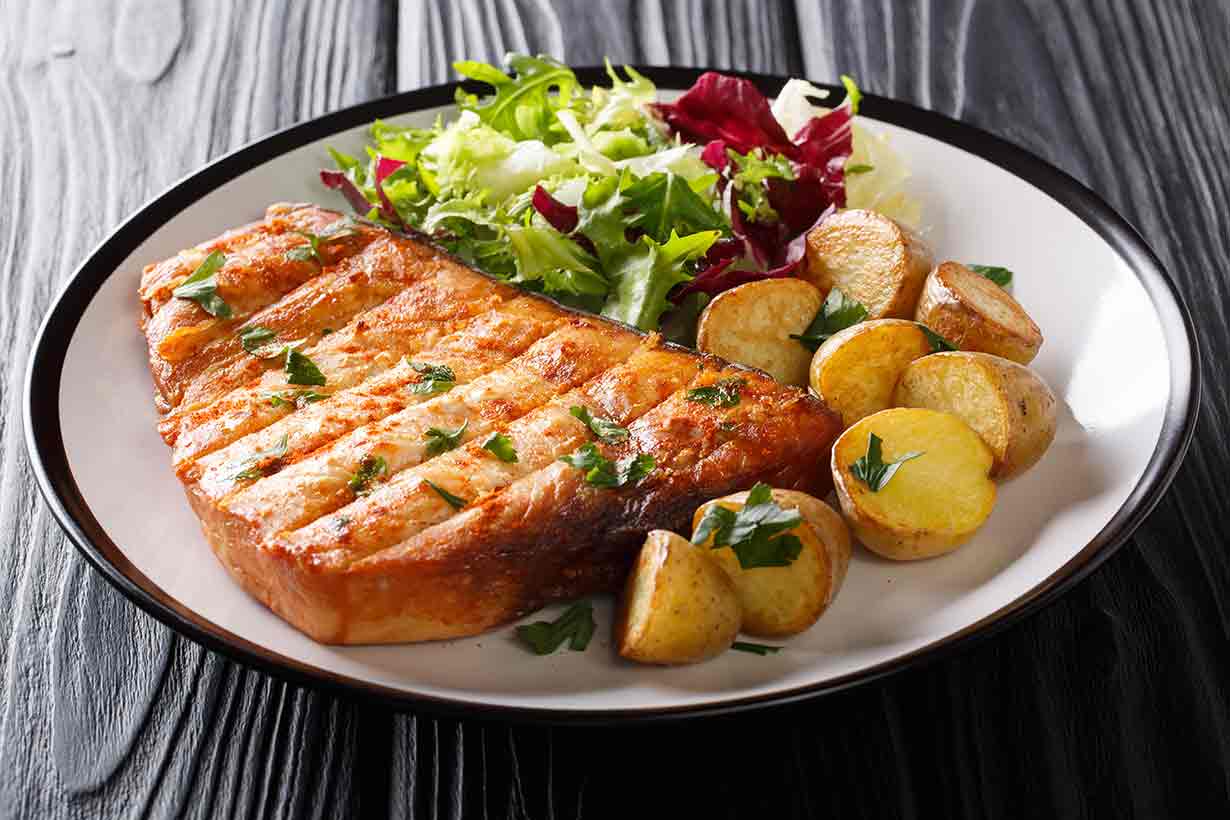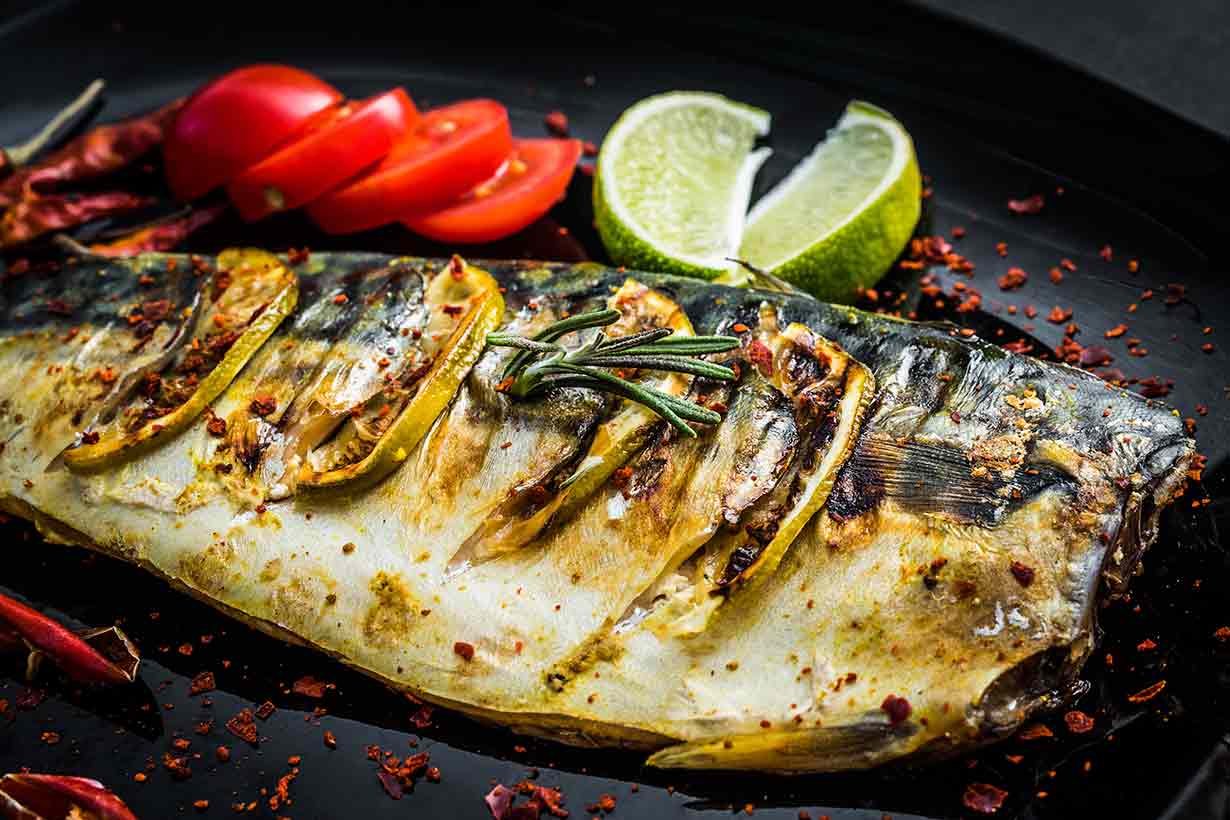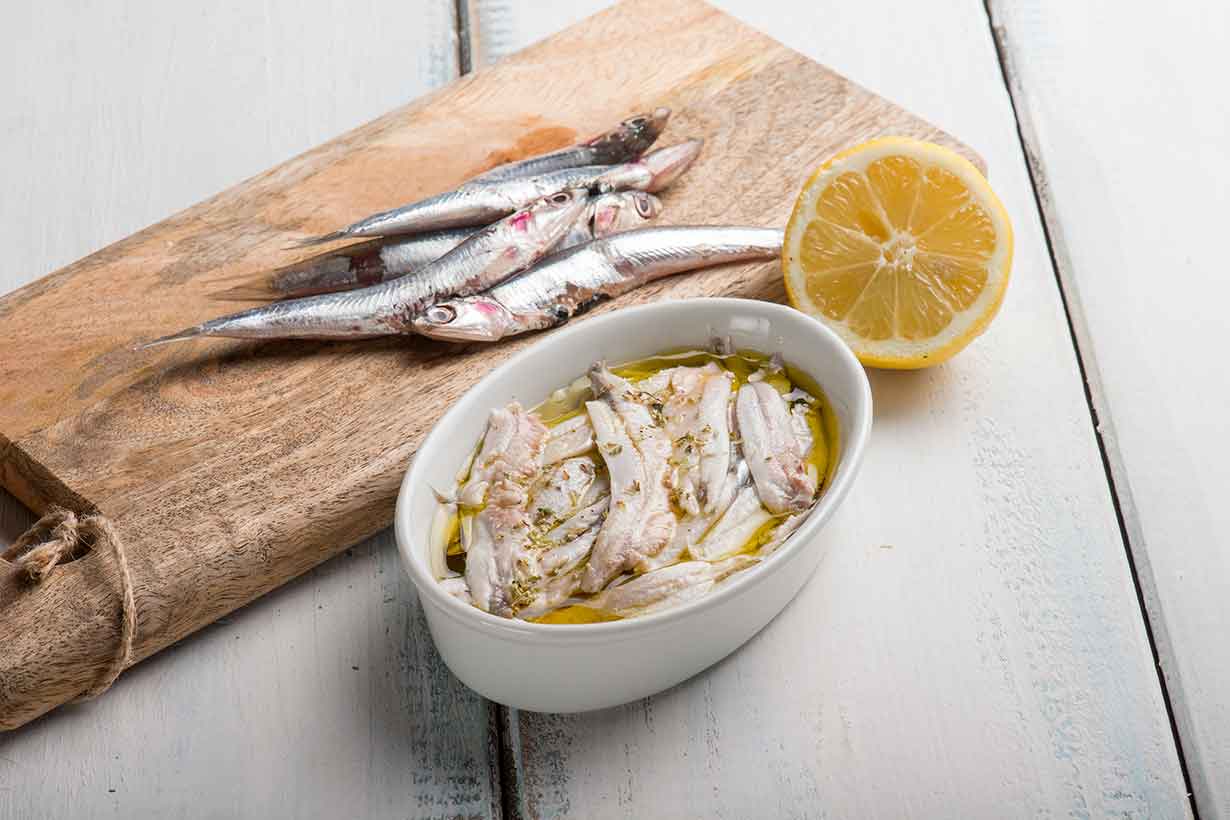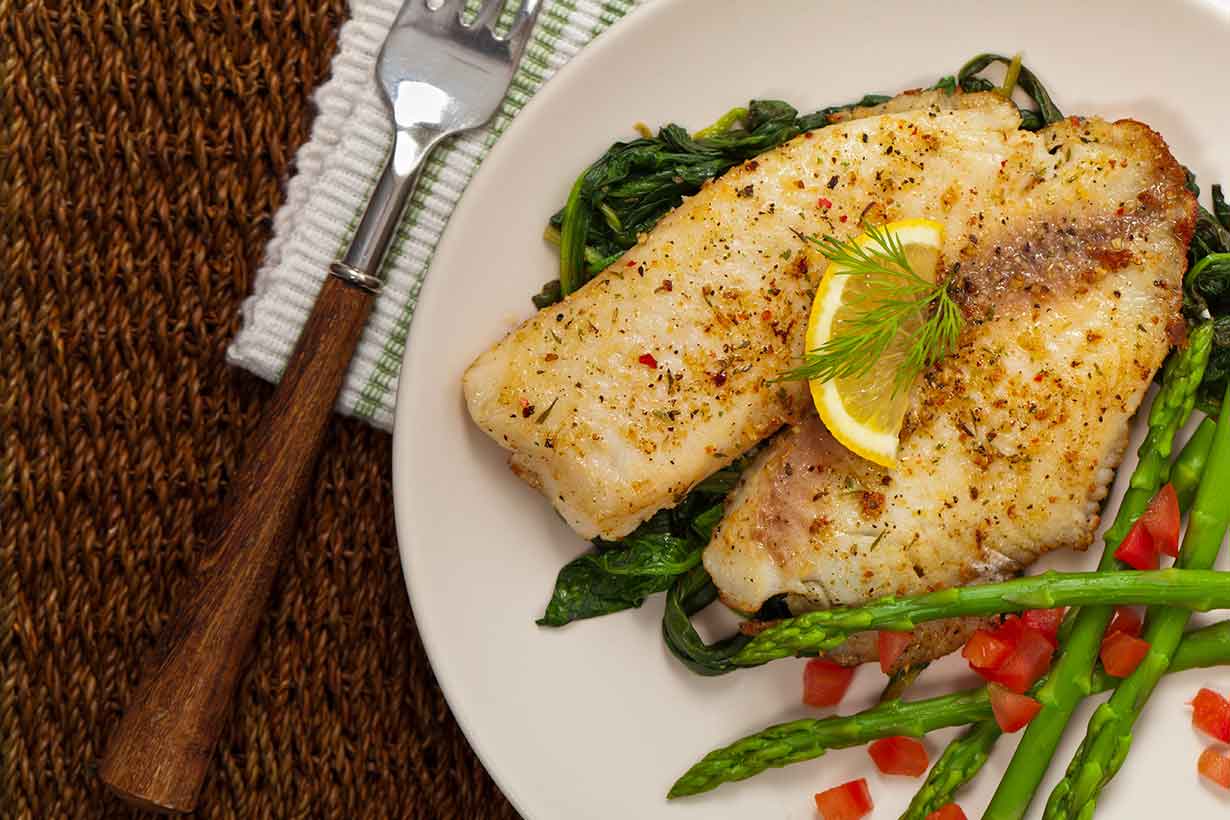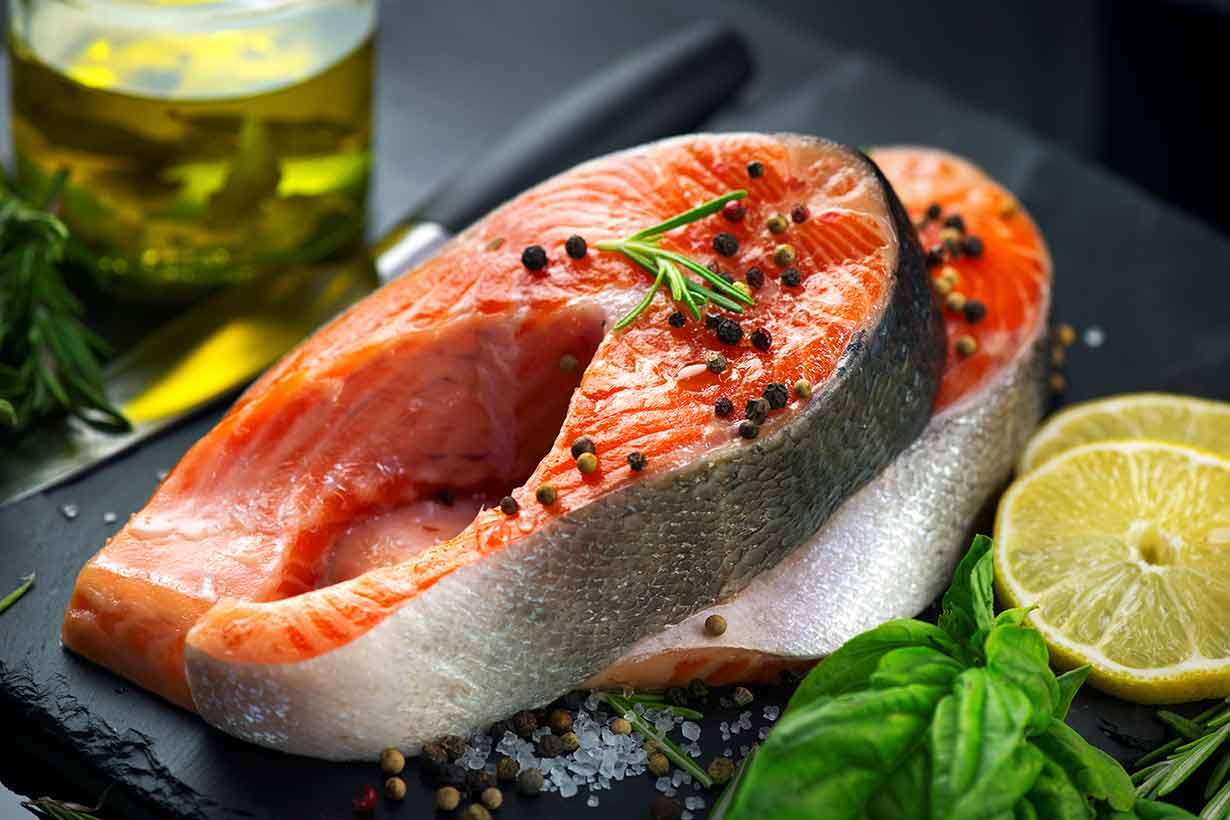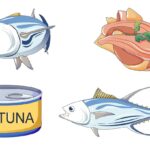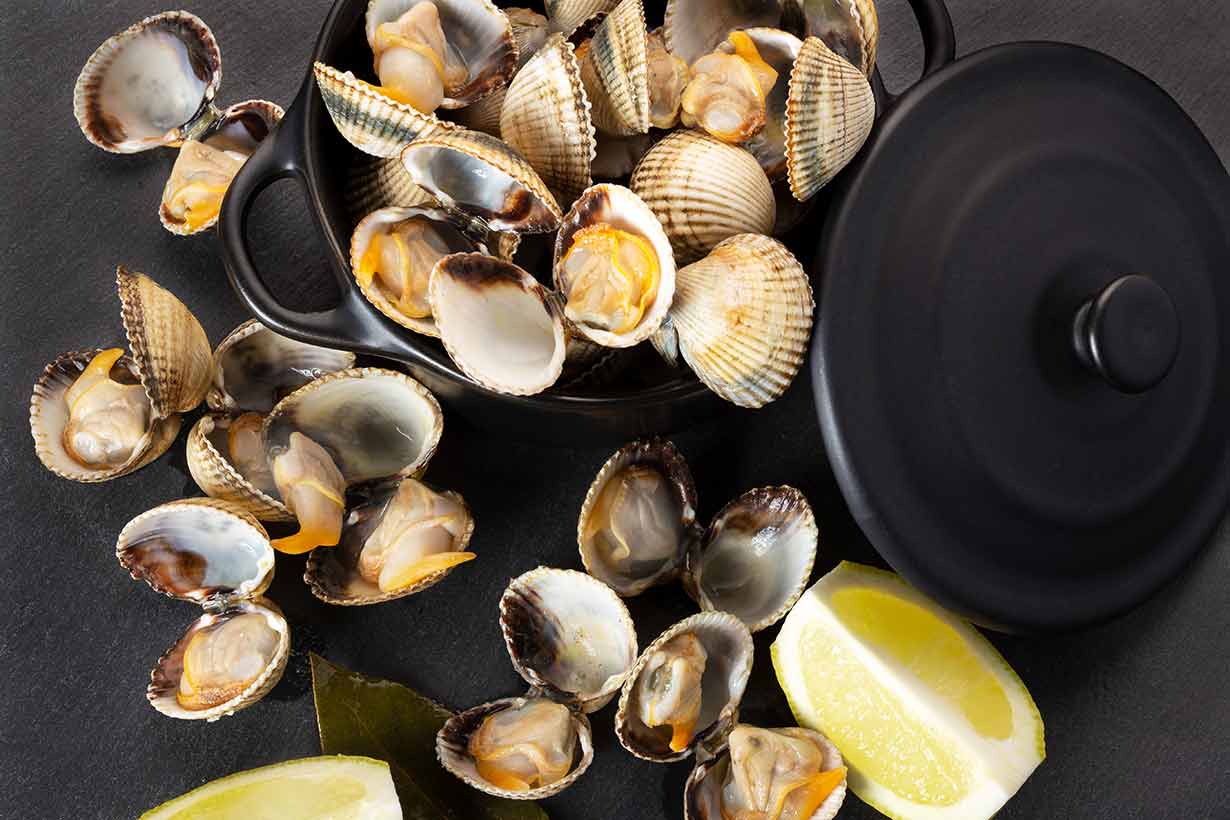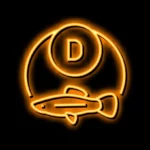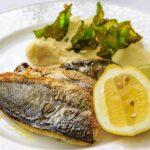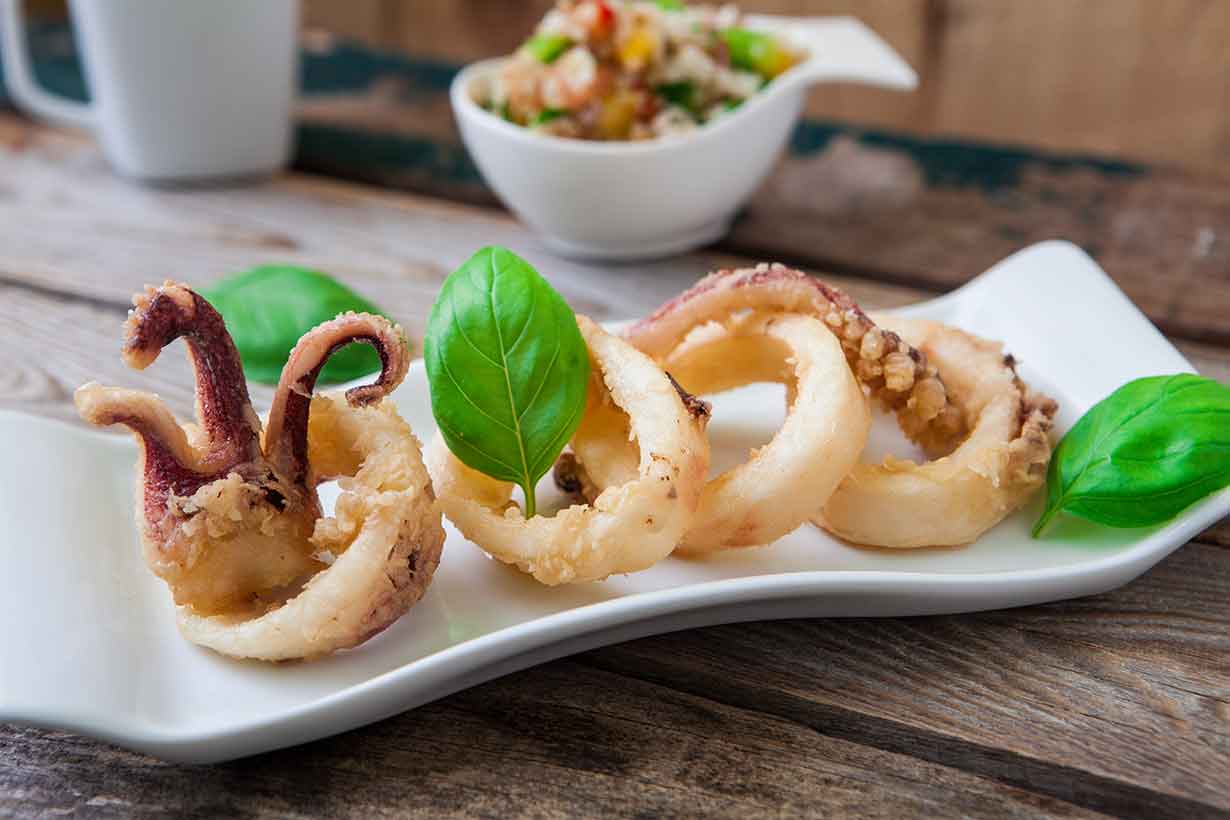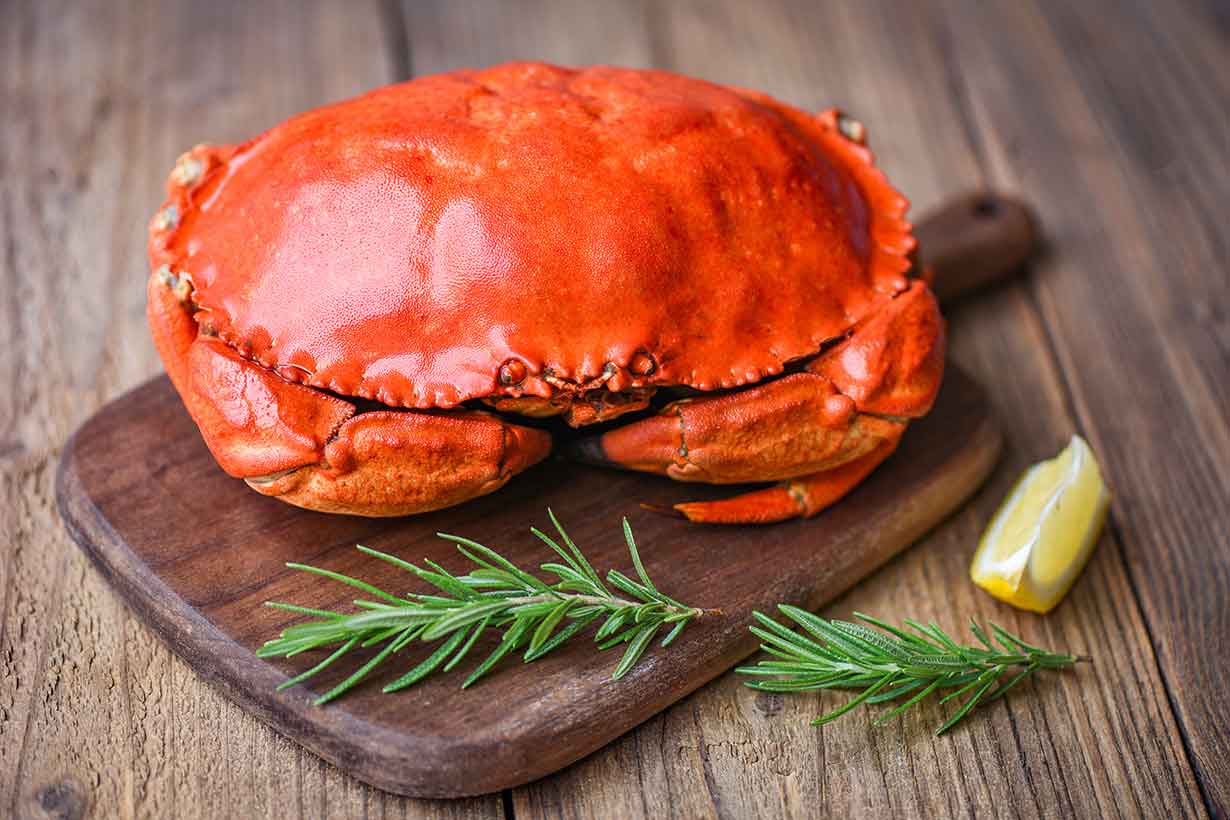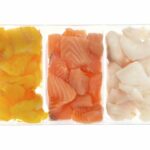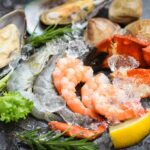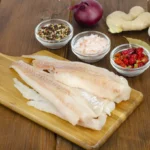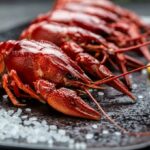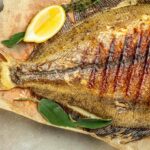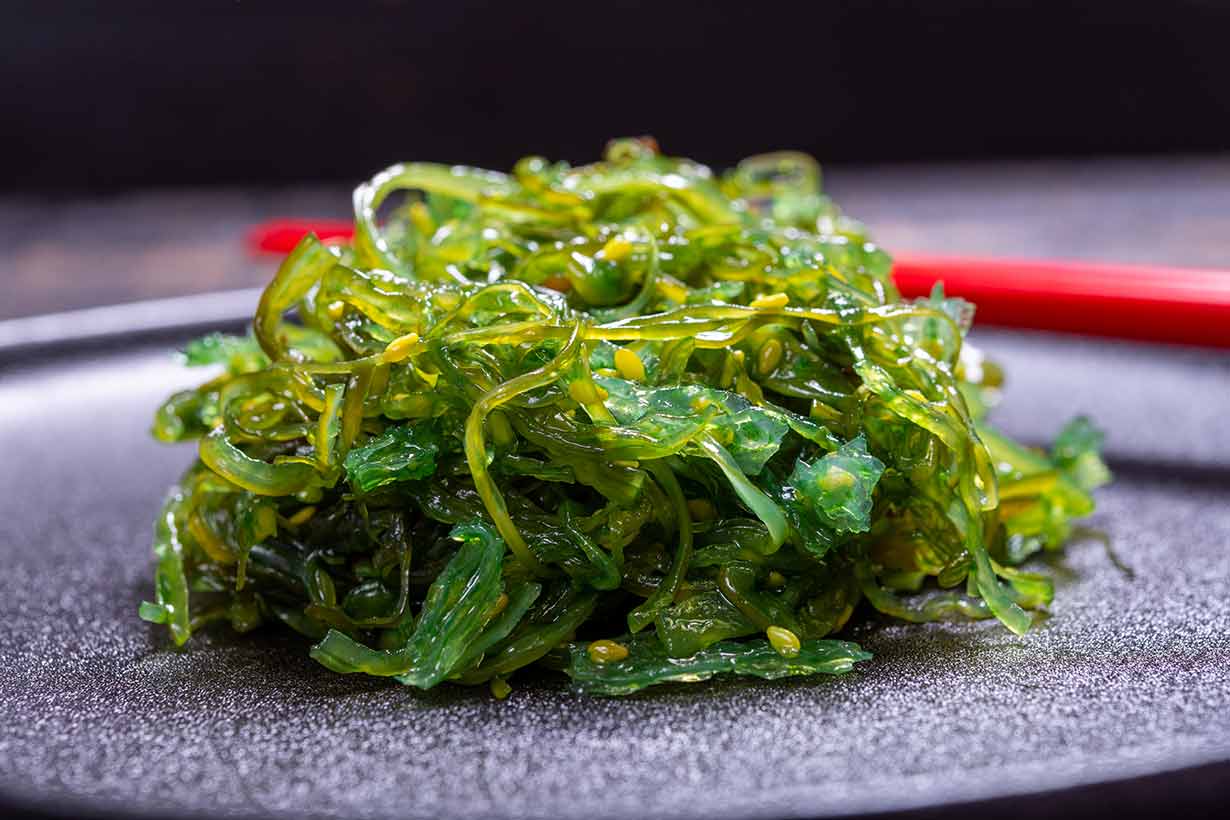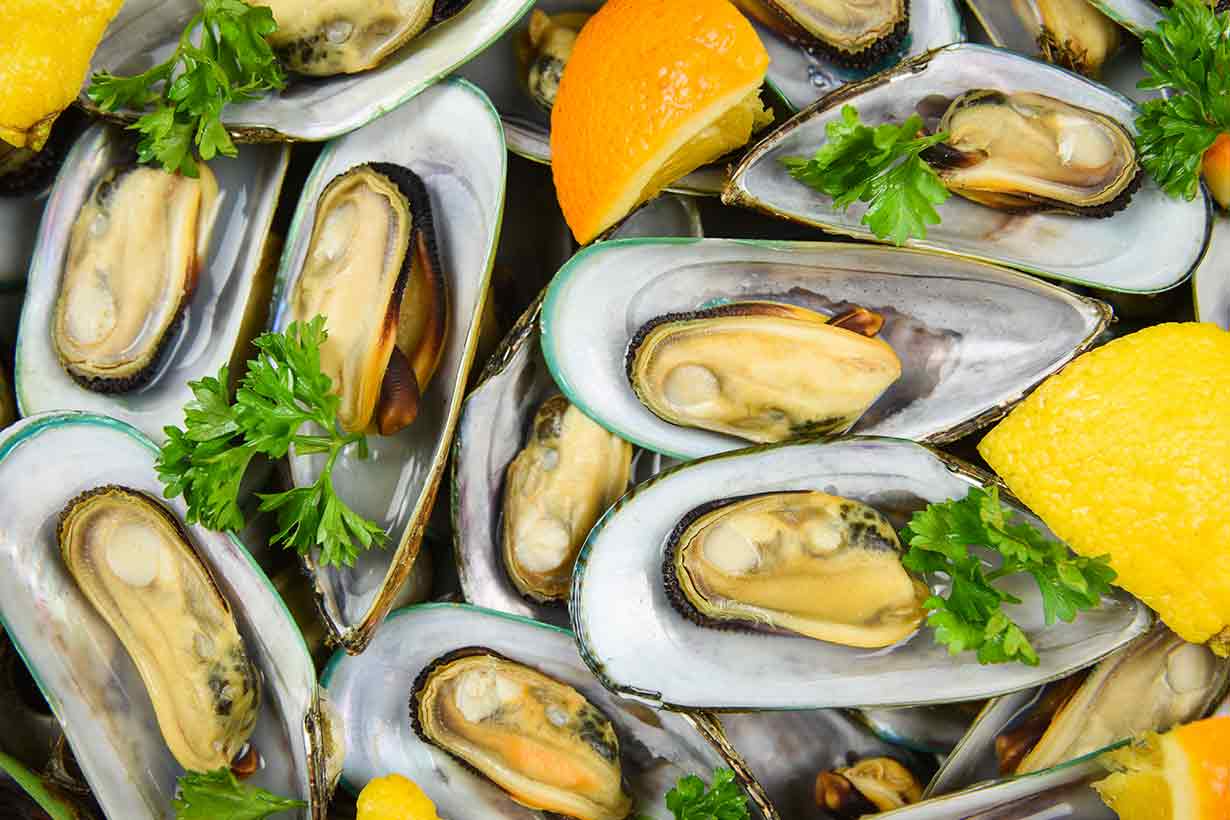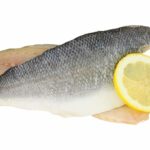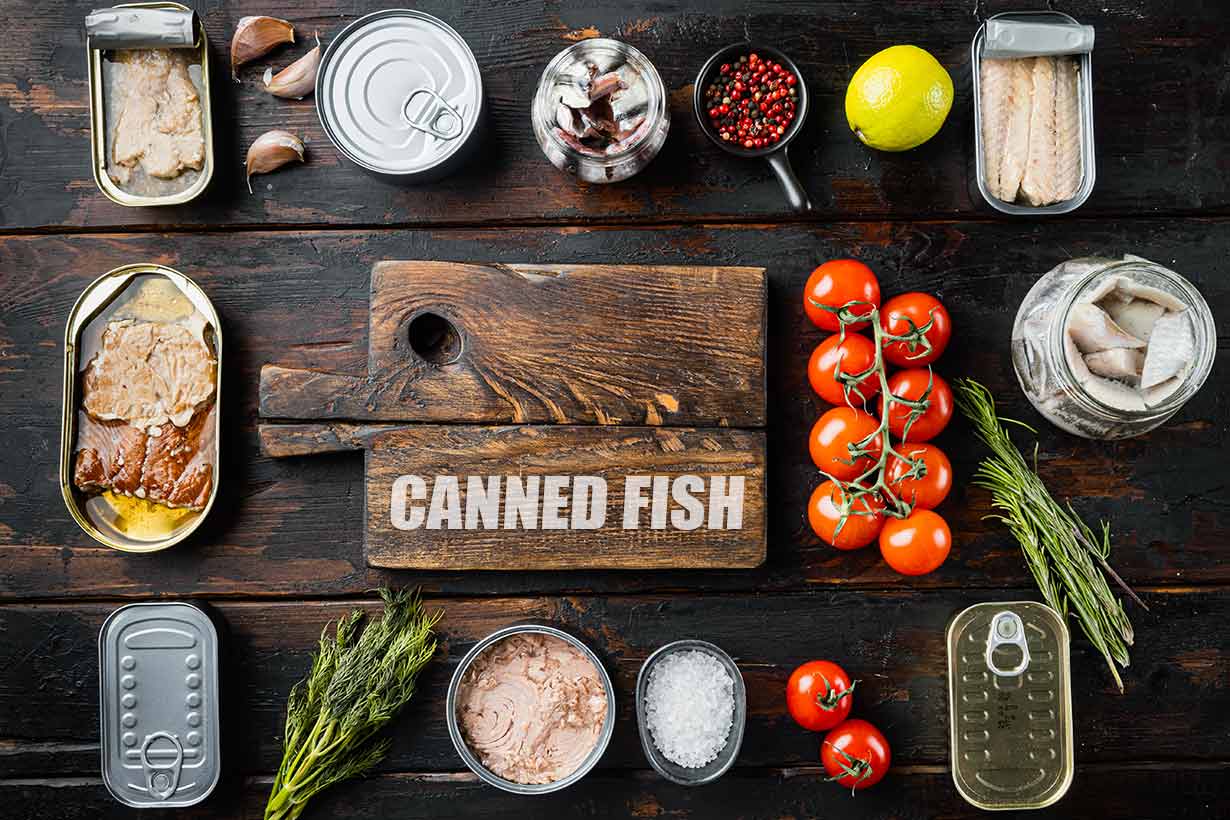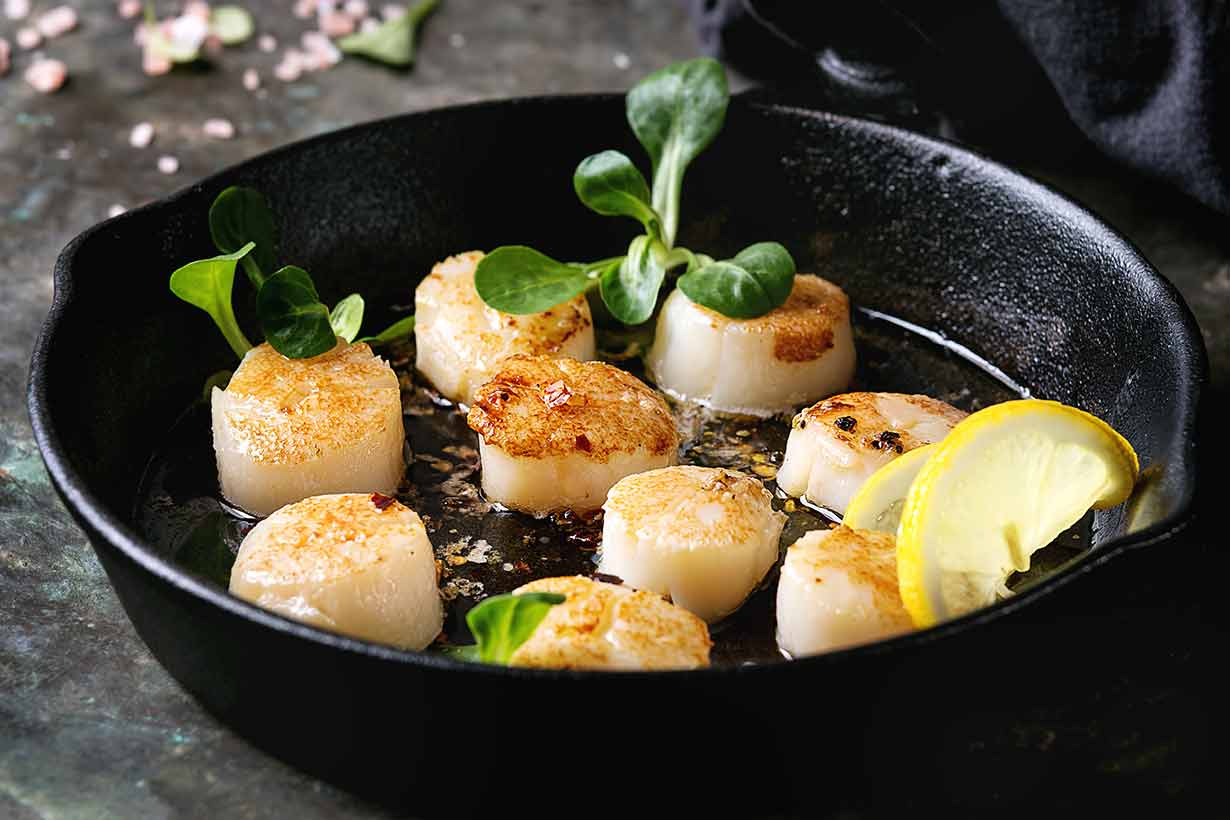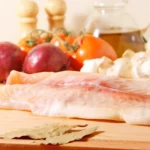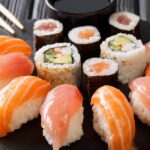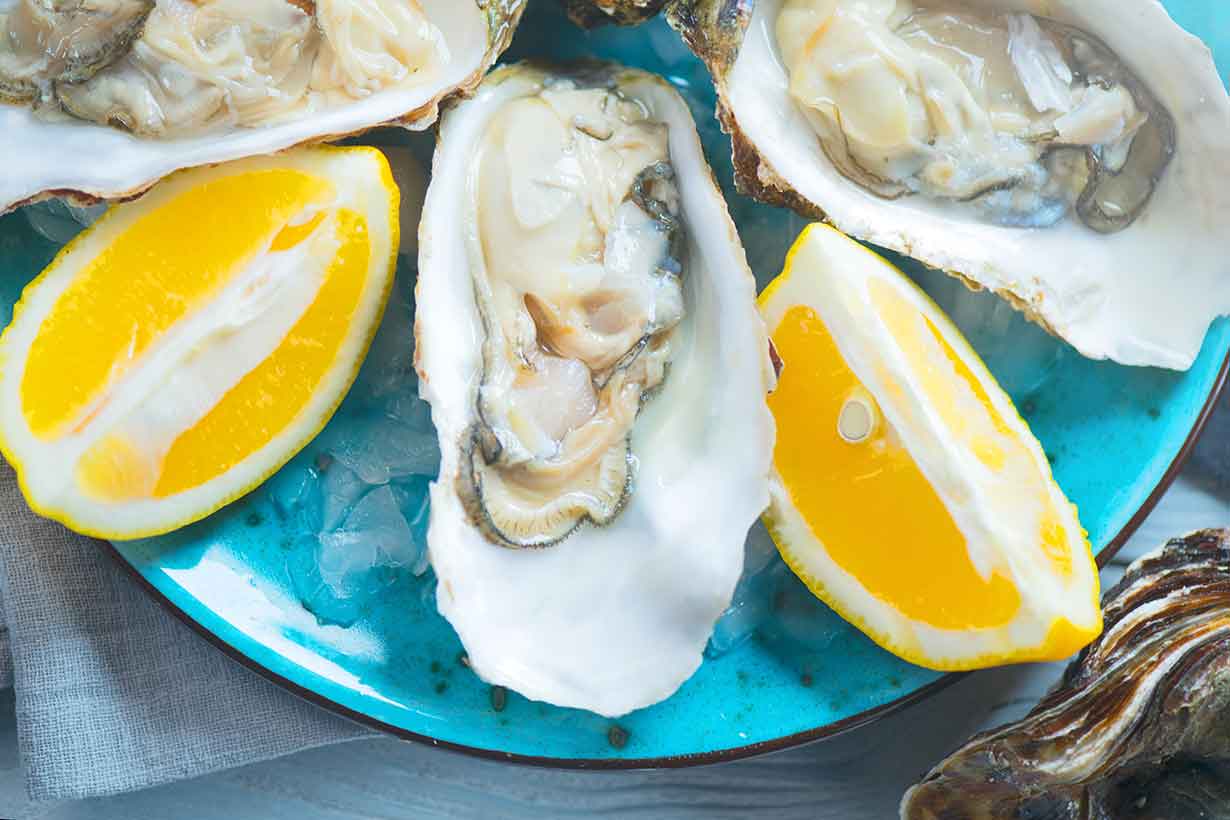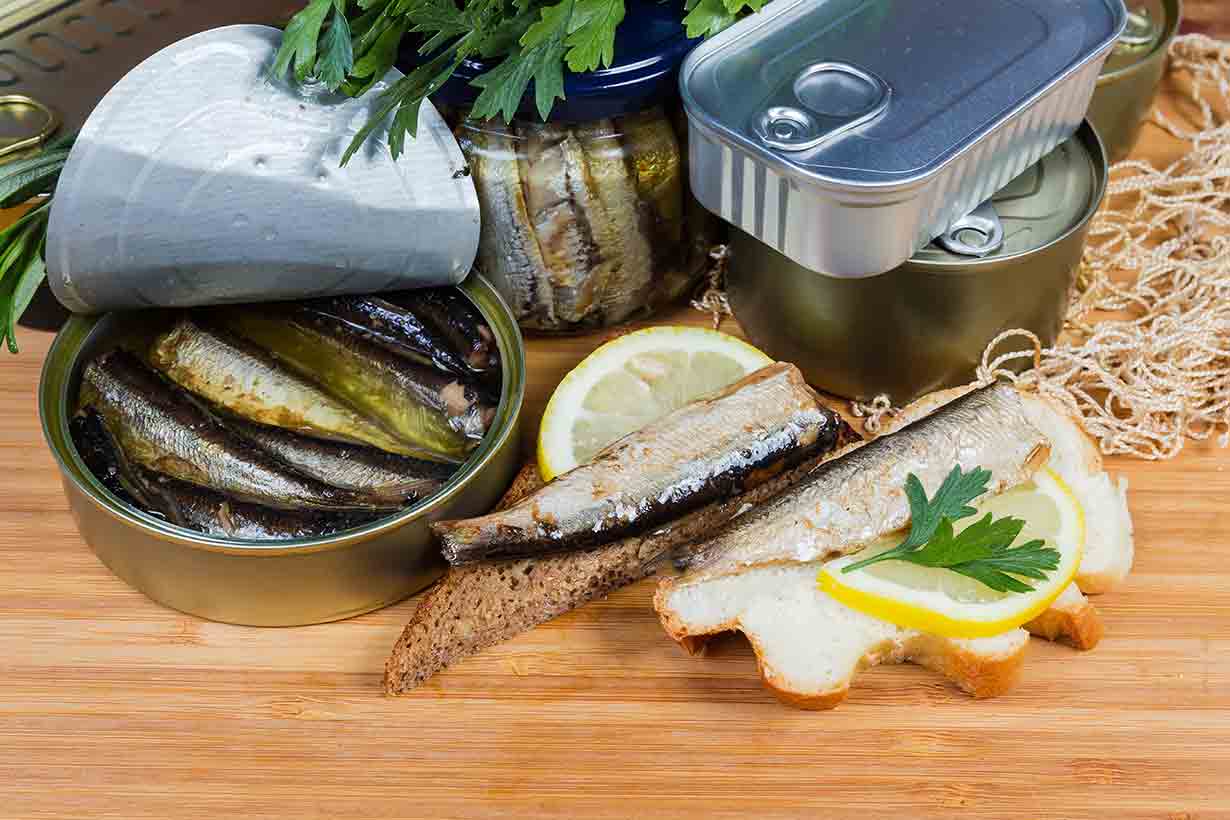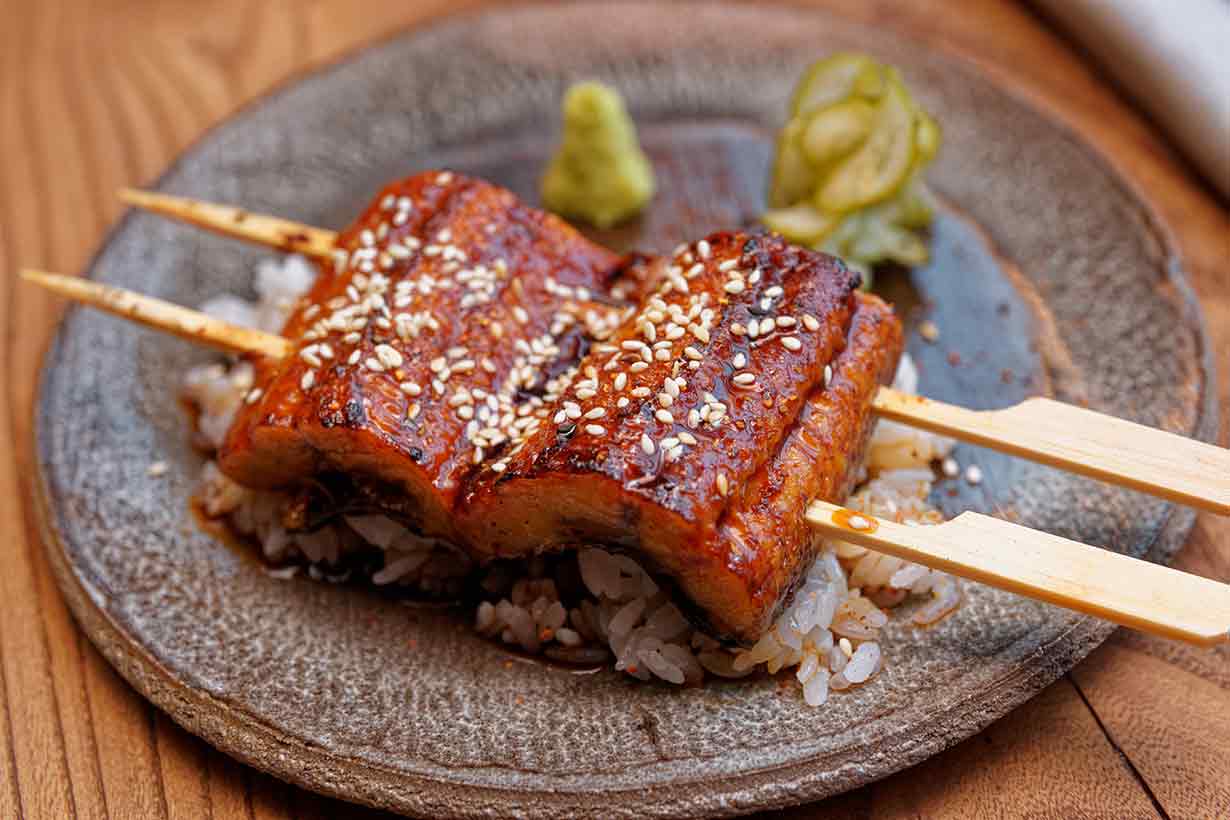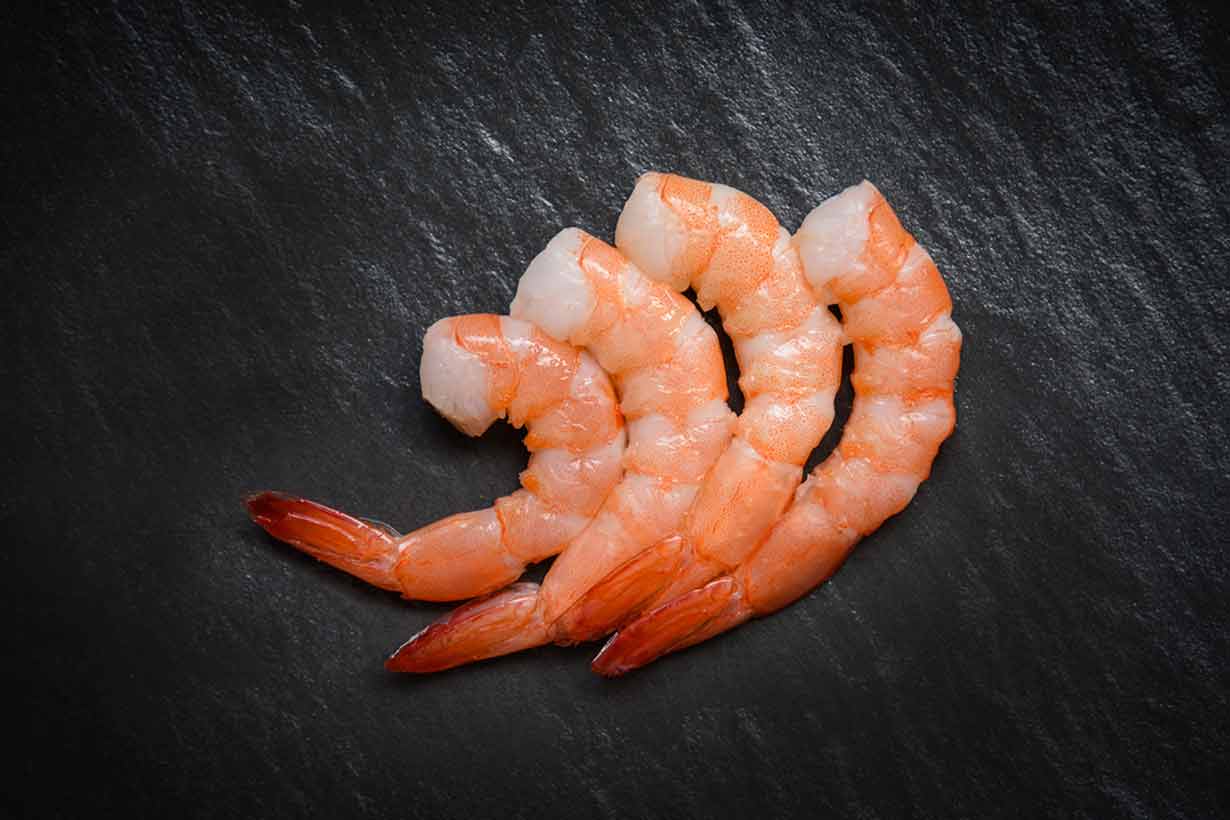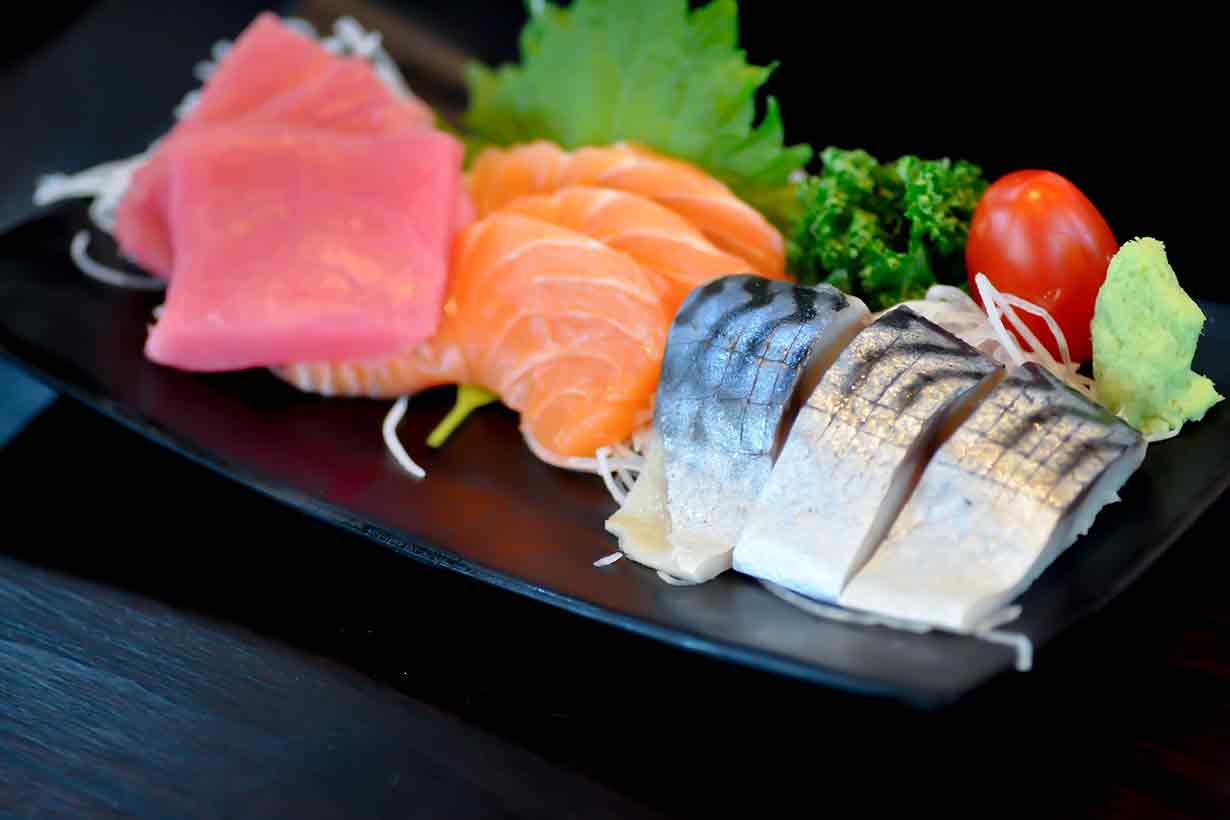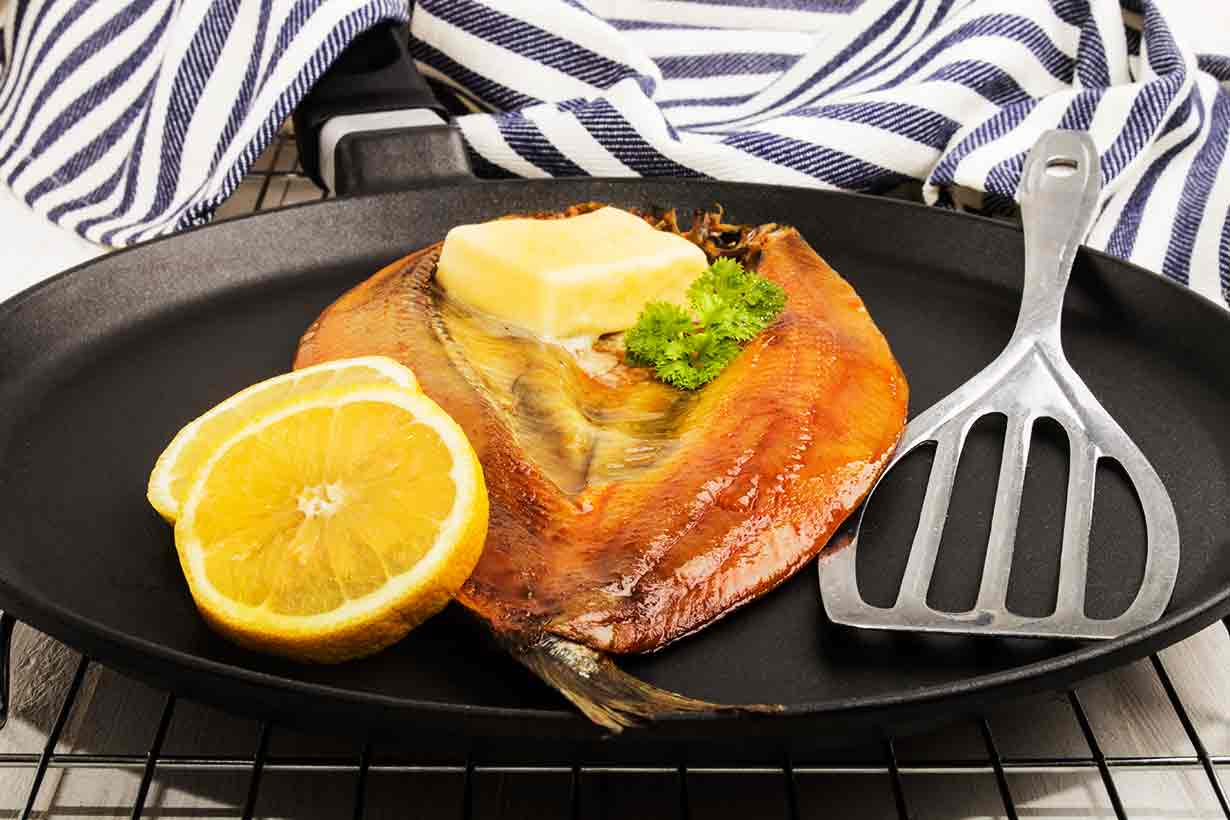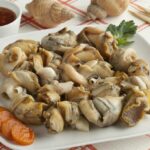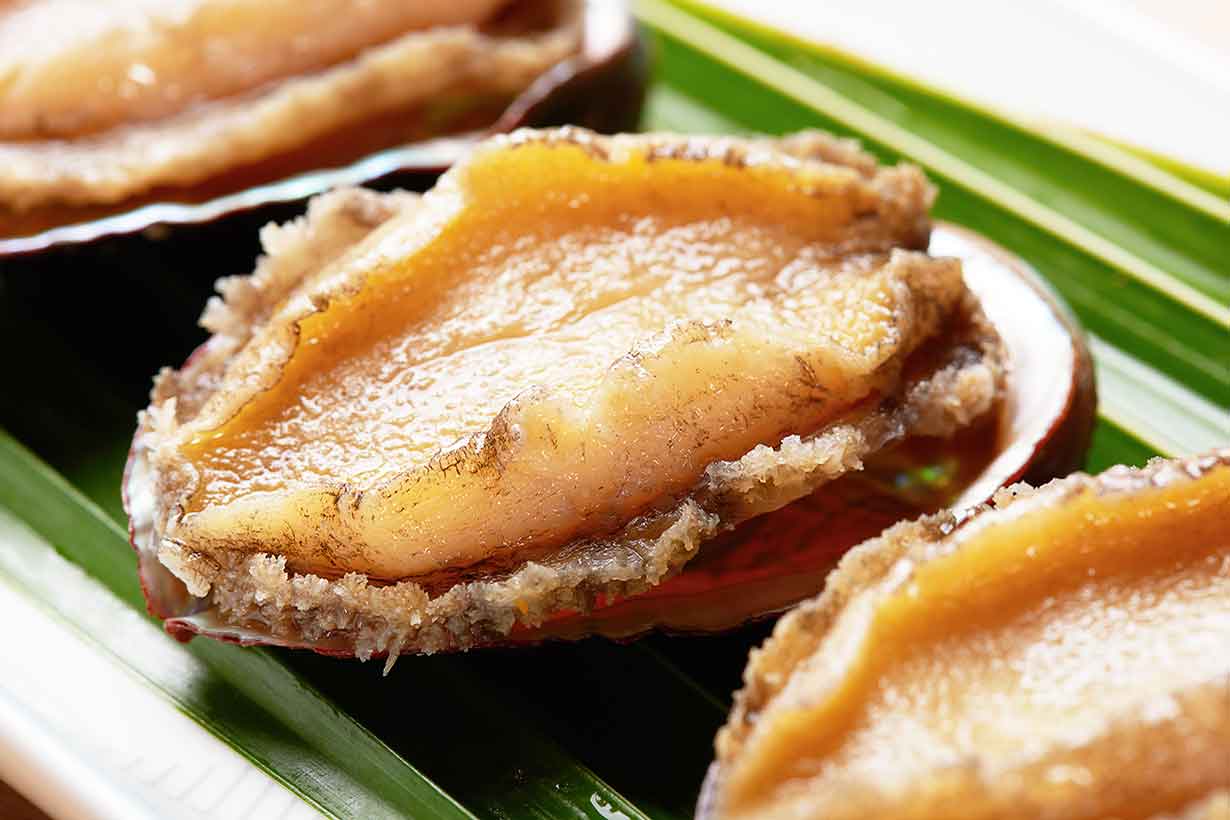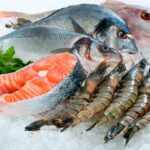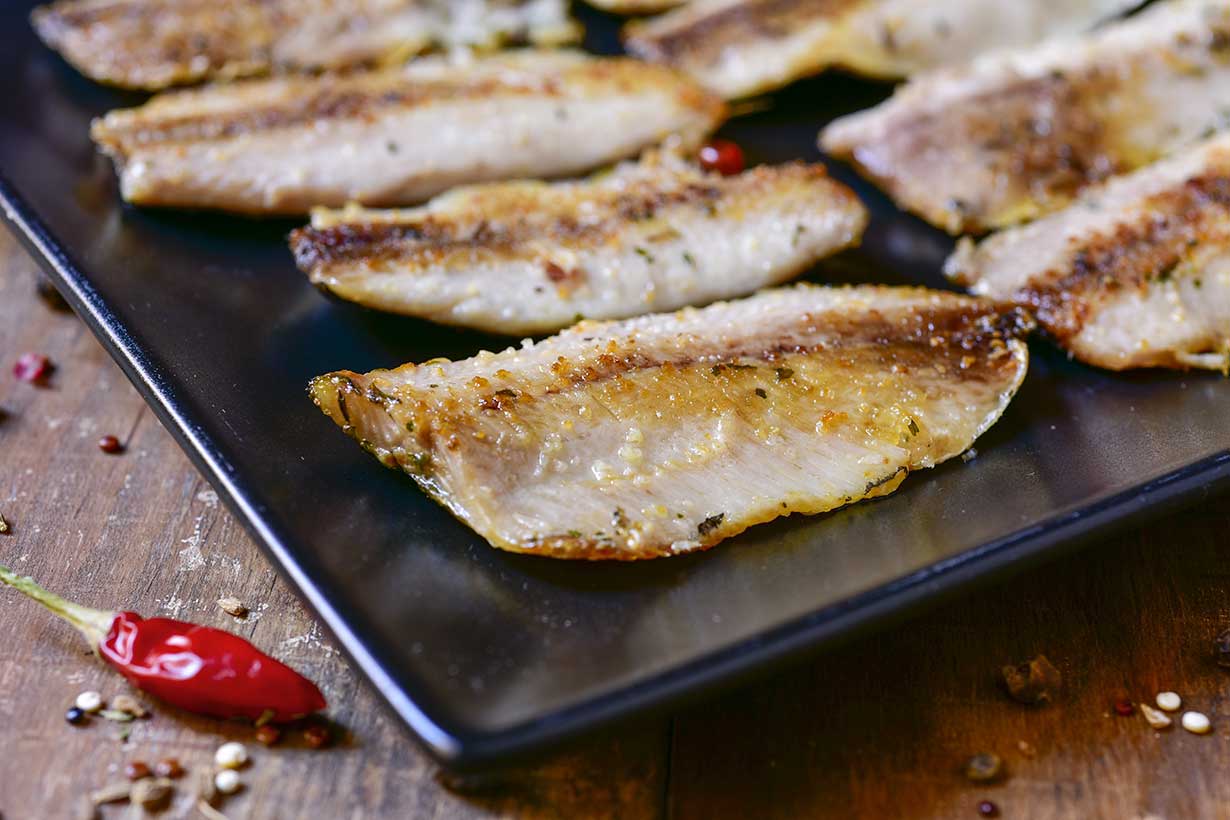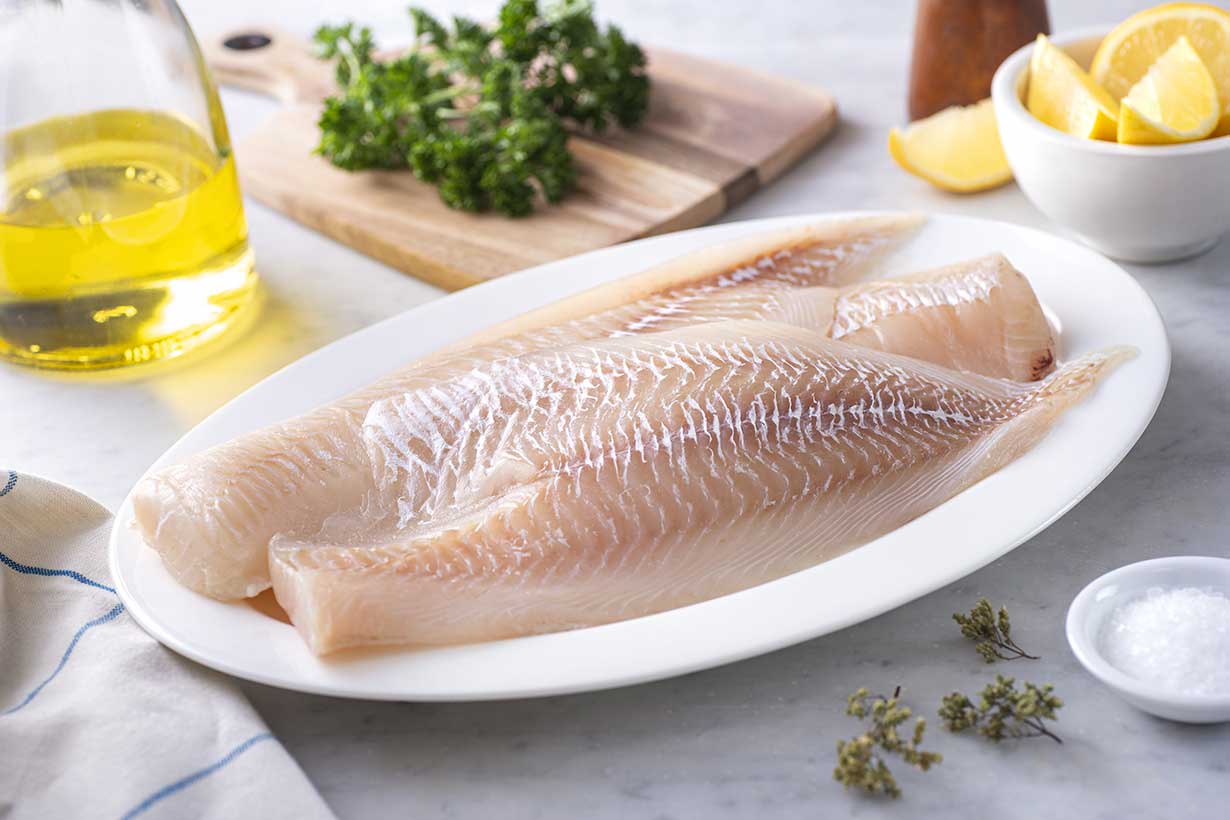Seafood represents a diverse range of food that includes fish, shellfish, and sea vegetables.
There are all kinds of different seafood, and they are some of the most nutritious foods we can eat.
They are also an important source of omega-3 fatty acids essential for our overall health.
This article examines different healthy types of seafood alongside their nutrition profile, omega-3 content, and the top three nutrients they contain.
If you want a healthier diet, including some of these foods is a great way to start.
Note: Unless otherwise stated, the source of all nutritional data is the USDA’s FoodData Central database.
1) Salmon (Atlantic, farmed, cooked)
Salmon is one of the most popular fish in the world, which is relatively easy to understand, given how delicious it tastes.
Also, salmon comes in all different shapes and sizes, and there are numerous popular species of salmon (see here for a complete guide to the differences).
Salmon is a versatile food choice, and we can eat it fresh, as raw fish (sashimi), or in canned form for convenience.
Nutritionally, salmon contains an impressive range of beneficial nutrients and some interesting bioactive compounds such as astaxanthin. Astaxanthin is a carotenoid that randomized controlled trials suggest may help improve human skin’s UV resistance and reduce skin aging (1, 2).
Additionally, salmon is extremely rich in essential omega-3 fatty acids.
Here is Atlantic salmon’s nutrition profile and key nutrients per 100 grams cooked (3):
- Calories: 206 kcal
- Carbohydrate: 0 g
- Fat: 12.4 g
- Saturated fat: 2.4 g
- Omega-3: 2.43 g
- Omega-6: 0.67 g
- Protein: 22.1 g
- Cholesterol: 55 mg
Key Nutrients
- Vitamin B12: 2.8 mcg (117% of the daily value)
- Selenium: 41.1 mcg (75% DV)
- Niacin: 8.04 mg (50% DV)
See this full overview of salmon’s benefits for a complete guide.
2) Oysters

With a slimy appearance, people seem to either love or hate this mollusk shellfish.
However, oysters are one of the healthiest seafood options.
In fact, oysters are one of the most nutrient-rich foods out there.
These popular shellfish provide a substantial amount of Zinc, copper, and B vitamins.
Additionally, oysters are a rare food source of vitamin D.
Here is a look at the nutritional values of cooked oysters per 100 grams (4):
- Calories: 79 kcal
- Carbohydrate: 7.28 g
- Fat: 2.12 g
- Saturated fat: 0.68 g
- Omega-3: 0.50 g
- Omega-6: 0.04 g
- Protein: 7.0 g
- Cholesterol: 38.0 mg
Key Nutrients
- Zinc: 45.2 mg (411% DV)
- Vitamin B12: 24.3 mcg (1013% DV)
- Copper: 1.43 mg (159% DV)
3) Trout
Trout is a cousin of salmon, and the two fish have a similar appearance.
The taste is also somewhat similar, but trout has a milder flavor than salmon, which could be a positive or a negative depending on personal preference.
Both of these fish share some positive traits, too. Specifically, they are high in omega-3, low in mercury, and offer an excellent source of vitamins and minerals.
For a tasty meal, try cooking trout in a lemon sauce.
You can find some recipes in this full guide to rainbow trout.
Per 100 grams, cooked rainbow trout offers (5):
- Calories: 168 kcal
- Carbohydrate: 0 g
- Fat: 7.38 g
- Saturated fat: 1.65 g
- Omega-3: 1.06 g
- Omega-6: 0.64 g
- Protein: 23.8 g
- Cholesterol: 70 mg
Key Nutrients
- Vitamin B12: 4.11 mcg (171% DV)
- Vitamin D: 19 mcg (95% DV)
- Selenium: 28.1 mcg (51% DV)
As shown, trout is an excellent source of vitamin B12 and vitamin D.
See this guide to vitamin D in fish for more information on the best sources.
4) Abalone

Similar to oysters, abalone is another shellfish that offers a significant amount of essential nutrients.
Interestingly, abalone is relatively low in fat yet offers a moderate source of carbohydrates, which is somewhat unusual for seafood.
Furthermore, abalone is an excellent source of iodine, an essential trace element. Unfortunately, many people are not consuming sufficient amounts of iodine, and approximately 2 billion people around the world have an iodine deficiency (6, 7).
Abalone has a soft and chewy texture and a creamy, salty taste.
Nutritionally, the NCC Food and Nutrient Database shows that cooked abalone offers the following nutrients per 100 grams (8):
- Calories: 107 kcal
- Carbohydrate: 9.70 g
- Fat: 0.20 g
- Saturated fat: 0.04 g
- Omega-3: 0.02 g
- Omega-6: 0 g
- Protein: 16.5 g
- Cholesterol: 98 mg
Key Nutrients
- Selenium: 48.6 mcg (88% DV)
- Vitamin B12: 0.69 mcg (29% DV)
- Vitamin K: 26.0 mcg (22% DV)
See this guide for more information: what is abalone and is it good for you?
5) Octopus
Although octopus is not so “normal” in traditional Western cuisine, it plays a significant part in various cuisines worldwide.
For instance, the octopus is a valued part of the diet in countries such as Japan, Korea, Singapore, and several Mediterranean countries.
On the negative side, octopus is one of those foods that people tend to either love or hate. Much of this depends on how the octopus cooks since overcooking can quickly make it too chewy.
To get around this, it is better to cook octopus either slowly on low heat or quickly but for a minimal amount of time.
Octopus is one of the healthiest types of seafood and has an impressive nutrient profile. Here are the values for cooked octopus per 100 grams (9):
- Calories: 164 kcal
- Carbohydrate: 4.4 g
- Saturated fat: 0.45 g
- Fat: 2.08 g
- Omega-3: 0.33 g
- Omega-6: 0.02 g
- Protein: 29.8 g
- Cholesterol: 96 mg
Key Nutrients
- Vitamin B12: 36.0 mcg (1500% DV)
- Selenium: 89.6 mcg (163% DV)
- Iron: 9.54 mg (53% DV)
6) Mackerel
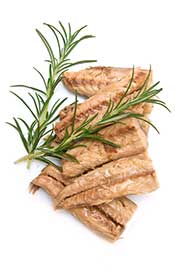
Mackerel is another oily fish that provides a great source of omega-3.
However, it is worth noting that there are several different species of mackerel, and not all of them are equally healthy.
Atlantic mackerel is the best bet because it contains very little mercury.
However, it is better to avoid King Mackerel and Spanish Mackerel since these fish can contain high amounts of this heavy metal (10).
Note: a list of canned fish: nutrition facts and mercury content.
One of the best things about mackerel is just how affordable it is. While salmon is delicious and very healthy, some families can struggle to afford it.
In contrast, mackerel sells for about half the price (or less), and canned or frozen mackerel is even more affordable.
In addition to omega-3, mackerel provides a decent range of vitamins and minerals. Here is the nutritional profile for cooked Atlantic mackerel per 100 grams (11):
- Calories: 262 kcal
- Carbohydrate: 0 g
- Fat: 17.8 g
- Saturated fat: 4.18 g
- Omega-3: 1.42 g
- Omega-6: 0.15 g
- Protein: 23.85 g
- Cholesterol: 75 mg
Key Nutrients
- Vitamin B12: 19 mcg (792% DV)
- Selenium: 51.60 mcg (94% DV)
- Vitamin B3: 6.85 mg (43% DV)
For more information, see: the health benefits of mackerel (and full nutrition facts).
7) Herring
Herring is a small and nutritious oily fish mainly living in the Atlantic and Pacific oceans. However, there are some freshwater varieties too.
Regarding taste, herring is quite strong and flavorful, and they are a little bit salty with a soft texture.
Herring also has an interesting history as a traditional breakfast, particularly in the UK and some areas in North America. This breakfast involves eating herring in their “kippered” state.
Kippers are whole herring fish that have been salted and smoked.
It is traditional to cook kippers with a bit of butter, and it makes a great breakfast.
Like other oily fish, herring provides a considerable number of nutrients. Here are the nutritional values for 100 grams of cooked herring (12):
- Calories: 203 kcal
- Carbohydrate: 0 g
- Fat: 11.6 g
- Saturated fat: 2.62 g
- Omega-3: 2.22 mg
- Omega-6: 0.17 mg
- Protein: 23.0 g
- Cholesterol: 77 mg
Key Nutrients
- Vitamin B12: 13.14 mcg (548% DV)
- Selenium: 46.80 mcg (85% DV)
- Phosphorus: 419 mg (34% DV)
Find out more here: the nutritional benefits of herring
8) Squid
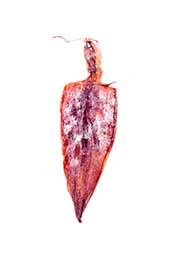
Squid is otherwise known as calamari, and it is a popular food in cuisines worldwide. It is a cephalopod member of the mollusk class of shellfish.
Depending on the country, it can be prepared in various ways. For example, in the Mediterranean region, chefs tend to either fry squid or serve it as a stew that incorporates vegetables.
In contrast, people may eat it raw in East Asia as sashimi or sushi.
Squid is a substantial source of several essential vitamins and minerals. Per 100 grams, here is what cooked squid offers (13):
- Calories: 155 kcal
- Carbohydrate: 3.83 g
- Fat: 6.25 g
- Saturated fat: 1.64 g
- Omega-3: 0.79 g
- Omega-6: 1.2 g
- Protein: 19.4 g
- Cholesterol: 293 mg
Key Nutrients
- Copper: 2.35 mg (261% DV)
- Selenium: 55.6 mcg (101% DV)
- Vitamin B2: 1.37 mcg (57% DV)
See this nutritional guide to squid for more information
9) Sardines
Sardines are one of the most affordable and nutritious fish.
First, we eat sardines in their whole form, including the organs and small bones they contain. As a result, they offer exceptional nutrient density and an excellent non-dairy source of calcium.
Furthermore, sardines provide an excellent source of vitamin B12 and selenium. They are also one of the most concentrated sources of omega-3 fatty acids.
Depending on location, sardines may be available in fresh or frozen form, but canned options are available worldwide.
Nutritionally, sardines canned in oil provide the following nutrients per 100 grams (14):
- Calories: 208 kcal
- Carbohydrate: 0 g
- Fat: 11.4 g
- Saturated fat: 1.53 g
- Omega-3: 1.48 g
- Omega-6: 3.54 g
- Protein: 24.6 g
- Cholesterol: 142 mg
Key Nutrients
- Vitamin B12: 8.94 mcg (373% DV)
- Selenium: 52.70 mcg (96% DV)
- Calcium: 382 mg (29% DV)
For more on their benefits, see this complete guide to sardines.
10) Seaweed
In addition to fish and shellfish, there is another category of seafood that can be incredibly nutritious: sea vegetables.
On the negative side, not many of us eat enough sea vegetables. In fact, most people in Western nations do not eat any at all.
The lack of attention sea vegetables receive is a shame, given their nutritional value.
Sea vegetables also contain some unique beneficial compounds. As mentioned earlier, iodine deficiency is relatively common. Sea vegetables can make a big difference here because they are the most iodine-rich foods available (15).
There is a wide variety of sea vegetables, but some of the most common include kombu, nori, and wakame.
Here is the nutrition profile for wakame per 100 grams (16):
- Calories: 45 kcal
- Carbohydrate: 9.14 g
- Fat: 0.64 g
- Saturated fat: 0.13 g
- Omega-3: 0.19 g
- Omega-6: 0.01 g
- Protein: 3.03 g
- Cholesterol: –
Key Nutrients
- Manganese: 1.4 mg (61% DV)
- Folate: 196 mcg DFE (49% DV)
- Sodium: 872 mg (38% DV)
See this guide to sea vegetables for more information.
11) Shrimp
Shrimp belongs to the crustacea family of shellfish and provides an excellent protein source and various micronutrients. It is one of the most popular types of seafood.
Shrimp also contains many nutrients that many people have a suboptimal intake of, such as selenium and choline (17, 18).
Despite historical fears over their cholesterol content, shrimp have been exonerated of blame over the past few years.
Notably, research has shown that dietary cholesterol has relatively little effect on blood cholesterol levels in most people (19, 20).
Per 100 grams, cooked shrimp provides the following nutrients (21):
- Calories: 119 kcal
- Carbohydrate: 1.52 g
- Fat: 1.7 g
- Saturated fat: 0.52 g
- Omega-3: 0.03 g
- Omega-6: 0.02 g
- Protein: 22.8 g
- Cholesterol: 211 mg
Key Nutrients
- Selenium: 49.50 mcg (90% DV)
- Vitamin B12: 1.66 mcg (69% DV)
- Phosphorus: 306 mg (24% DV)
See this guide to the benefits and drawbacks of shrimp for a full review.
12) Clams

Clams are another type of shellfish that offer exceptional nutritional value.
Belonging to the mollusk family of shellfish, they have a salty taste and a soft, chewy texture.
Typically, people either eat lightly seasoned clams on their own, but they also work well in various soups and stews.
Nutritionally speaking, clams offer some excellent benefits and provide an excellent source of vitamin B12.
Here is a look at their nutrition profile per 100 grams, cooked weight (22):
- Calories: 148 kcal
- Carbohydrate: 5.13 g
- Fat: 1.95 g
- Saturated fat: 0.19 g
- Omega-3: 0.40 g
- Omega-6: 0.03 g
- Protein: 25.55 g
- Cholesterol: 67 mg
Key Nutrients
- Vitamin B12: 98.9 mcg (4120% DV)
- Selenium: 64 mcg (116% DV)
- Manganese: 1.0 mg (43% DV)
Please find out more here: a nutritional guide to clams and their benefits
13) Cockles
Cockles are a type of bivalve mollusk that is quite similar to clams.
However, unlike clams, the natural habitat of cockles includes both freshwater and saltwater.
It is possible to buy fresh cockles, but they are more widely available in a pickled form sold in jars. There are no fundamental differences between these two forms of cockles, and both fresh and pickled cockles are nutrient-rich choices.
Per 100 grams, here are the basic nutritional values for cockles (23):
- Calories: 79 kcal
- Carbohydrate: 4.7 g
- Fat: 0.7 g
- Saturated fat: 0.07 mg
- Omega-3: 0.16 g
- Omega-6: 0.04 g
- Protein: 13.5 g
- Cholesterol: 36 mg
Key Nutrients
- Vitamin B12: 52.27 mcg (1288% DV)
- Vitamin B6: 3.25 mg (191% DV)
- Iron: 16.2 mg (90% DV)
For more information on cockles, see this full guide.
14) Anchovies
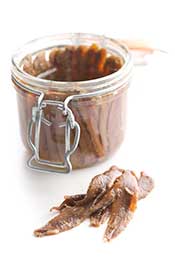
As small oily fish, they share some common traits with sardines.
However, these two fish are entirely different species and belong to separate fish families.
There is quite a big difference in their taste too. For instance, anchovies are notably stronger in flavor, and sardines are relatively mild.
Anchovies are almost always preserved in brine or salt-cured too, which gives them a saltier taste.
Due to these differences, sardines work better eaten alone, but anchovies contribute a fuller flavor when used in various dishes.
Similar to sardines, we often eat anchovies in their whole fish form, and they offer an impressive range of nutrients. Per 100 grams, anchovies provide (24):
- Calories: 131 kcal
- Carbohydrate: 0 g
- Fat: 4.8 g
- Saturated fat: 1.28 g
- Omega-3: 1.48 g
- Omega-6: 0.1 g
- Protein: 20.4 g
- Cholesterol: 60 mg
Key Nutrients
- Niacin: 14 mg (88% DV)
- Selenium: 36.5 mcg (66% DV)
- Copper: 0.21 mg (23% DV)
For more information, see this guide: the nutritional benefits of anchovies
15) Mussels
Mussels belong to the mollusk family of shellfish, and like oysters and clams, they offer many benefits.
Most notably, mussels are a substantial source of B vitamins and the mineral manganese. They also offer a decent amount of omega-3.
Regarding taste, they are both mild and salty, with a soft and chewy texture.
Like other shellfish, we can eat them alone with various seasonings like lemon, soy sauce, garlic, and butter.
Additionally, they work well in a range of cooked dishes. For example, Thai-style mussel curries are famous around the world. There is a good recipe for Thai coconut mussels here for anyone interested.
Here is a look at the nutrition profile for cooked mussels per 100 grams (25):
- Calories: 172 kcal
- Carbohydrate: 7.4 g
- Fat: 4.5 g
- Saturated fat: 0.85 g
- Omega-3: 0.94 g
- Omega-6: 0.18 g
- Protein: 23.8 g
- Cholesterol: 56 mg
Key Nutrients
- Vitamin B12: 24 mcg (1000% DV)
- Selenium: 89.6 mcg (163% DV)
- Manganese: 6.8 mg (296% DV)
This complete guide to mussels offers a full look at their nutritional values and health properties.
16) Crab
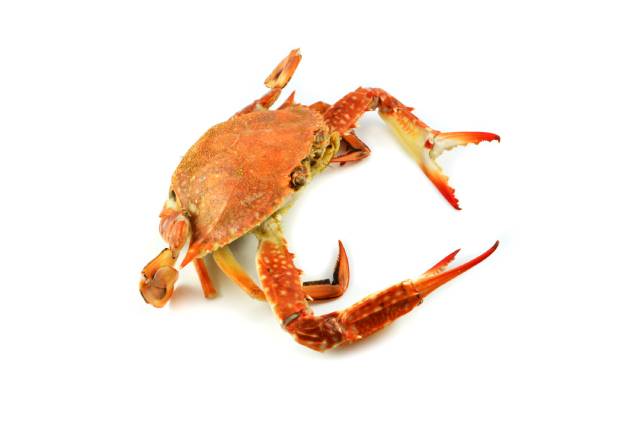
Interestingly, crab is very low in calories and only contains minimal fat.
Despite this, crab offers a lot of nutritional value and is a sizeable source of numerous vitamins and minerals.
While crab tastes somewhat similar to white fish, it is very mild in flavor with hints of sweetness and has a softer texture.
On the downside, one negative point about crab is that many people suffer from shellfish allergies. This allergy is not unique to crab and impacts fellow members of the crustacea family of shellfish, including shrimp and lobster.
Approximately 0.5 to 2.5% of the world’s population suffer from this potentially serious shellfish allergy (26).
Cooked crab offers the following nutrients per 100 grams (27):
- Calories: 97 kcal
- Carbohydrate: 0 g
- Fat: 1.5 g
- Saturated fat: 0.13 g
- Omega-3: 0.46 g
- Omega-6: 0.02 g
- Protein: 19.4 g
- Cholesterol: 53 mg
Key Nutrients
- Vitamin B12: 11.5 mcg (479% DV)
- Copper: 1.18 mg (131% DV)
- Selenium: 40 mcg (73% DV)
For more information, see this guide to crab and its nutritional benefits.
And for anyone wondering how ‘crab sticks’ compare to the real thing, see this guide to imitation crab meat.
17) Lobster
Lobster is a popular (but expensive) variety of shellfish.
While it is very nutritious, it is an occasional treat for most people due to its high price tag.
Lobster is high in protein and offers a good range of essential nutrients for very few calories.
On the downside, lobster is one of the most common causes of allergic reactions among shellfish, behind shrimp and crab (28).
Cooked lobster offers the following nutrients per 100 grams (29):
- Calories: 89 kcal
- Carbohydrate: 0 g
- Fat: 0.9 g
- Saturated fat: 0.21 g
- Omega-3: 0.25 g
- Omega-6: 0.07 g
- Protein: 19.0 g
- Cholesterol: 146 mg
Key Nutrients
- Copper: 1.55 mg (172% DV)
- Selenium: 73.1 mcg (132% DV)
- Vitamin B12: 1.43 mcg (60% DV)
This guide to the benefits and drawbacks of lobster provides further information.
18) Eel
While eel has a very long body and slightly resembles a snake, it is a variety of fish.
This fish has long been a traditional food in much of Europe and the United States, but it has declined in popularity over recent decades. In recent times, eel is incredibly popular in East Asia, particularly in China, Japan, Korea, and Taiwan.
Eel has an impressive nutritional profile, and it offers the following nutrients per 100 grams, cooked weight (30):
- Calories: 236 kcal
- Carbohydrate: 0 g
- Fat: 15.0 g
- Saturated fat: 3.02 g
- Omega-3: 0.58 g
- Omega-6: 0.37 g
- Protein: 23.6 g
- Cholesterol: 161 mg
Key Nutrients
- Vitamin A: 1140 mcg RAE (126% DV)
- Vitamin B12: 2.89 mcg (120% DV)
- Phosphorus: 277 mg (22% DV)
For more information, see this guide to eel’s nutritional benefits.
19) Fish Roe
Fish roe is otherwise known as fish eggs.
While not such a typical food in the Western world, it is extremely popular in Japan and Eastern Russia.
Fish roe is also highly nutritious and packs an impressive amount of nutrients, including omega-3, vitamin D, significant amounts of protein, and much more.
There are many different kinds of roe, so no set of generic nutritional values will be accurate for a particular “roe.”
However, see this guide to salmon roe for more information on one of the most popular types of fish eggs.
20) Sprats
Sprats are a lesser-known member of the Clupeiform family of fish, which also includes anchovies, herring, and sardines.
Despite their small size, sprats are packed with nutritional value.
Per 100-gram serving, this fish offers (31):
- Calories: 157 kcal
- Carbohydrate: 0 g
- Fat: 6.53 g
- Saturated fat: 1.47 g
- Omega-3: 1.38 g
- Omega-6: 0.14 g
- Protein: 23.0 g
- Cholesterol: 43 mg
Key Nutrients
- Vitamin B12: 13.14 mcg (548% DV)
- Selenium: 46.80 mcg (85% DV)
- Niacin (B3): 4.12 mg (26% DV)
See the full nutritional values and benefits of sprats for more information.
21) Swordfish
Swordfish is a large fish that is one of the ocean’s biggest predators.
However, this fish has positive aspects and some negative ones.
For example, it is very high in omega-3 fatty acids but contains large amounts of mercury (32).
See this detailed guide to the pros and cons of swordfish for more information.
Per 100-gram serving, cooked swordfish provides (33):
- Calories: 172 kcal
- Carbohydrate: 0 g
- Fat: 7.93 g
- Saturated fat: 1.91 g
- Omega-3: 1.10 g
- Omega-6: 0.11 g
- Protein: 23.4 g
- Cholesterol: 78 mg
Key Nutrients
- Selenium: 68.5 mcg (125% DV)
- Vitamin D: 16.6 mcg (83% DV)
- Vitamin B12: 1.62 mcg (68% DV)
22) Scallops
Scallops are a variety of mollusk shellfish that share some common properties with clams.
However, scallops have a much larger adductor muscle inside the shell – otherwise known as ‘meat’ for culinary purposes.
To learn more about them, see this full nutritional guide to scallops.
Per 100-gram serving, cooked scallops provide (34):
- Calories: 69 kcal
- Carbohydrate: 3.18 g
- Fat: 0.49 g
- Saturated fat: 0.13 g
- Omega-3: 0.11 g
- Omega-6: 0.01 g
- Protein: 12.1 g
- Cholesterol: 24 mg
Key Nutrients
- Vitamin B12: 1.41 mcg (59% DV)
- Phosphorus: 334 mg (27% DV)
- Selenium: 12.8 mcg (23% DV)
23) Sashimi
Sashimi is a Japanese raw fish delicacy that comes in all shapes and forms.
Providing the raw fish has been appropriately prepared; it is also very nutritious as well as tasting delicious.
Some of the most popular types of sashimi include bream, salmon, shrimp, and tuna.
For more information on sashimi, how it’s made, and the different varieties, see this guide to sashimi.
24) Haddock
Haddock is one of the most popular fish for culinary purposes.
This lean fish is a rich source of protein, and it is packed full of vitamins and minerals.
See this full nutritional guide to haddock for a complete overview.
Per 100-gram serving, cooked haddock offers (35):
- Calories: 90 kcal
- Carbohydrate: 0 g
- Fat: 0.55 g
- Saturated fat: 0.11 g
- Omega-3: 0.17 g
- Omega-6: 0.02 g
- Protein: 20.0 g
- Cholesterol: 66 mg
Key Nutrients
- Vitamin B12: 2.13 mcg (89% DV)
- Selenium: 31.7 mcg (58% DV)
- Niacin: 4.12 mg (26% DV)
For other lean white fish options, basa fish, cod, and swai fish are good choices.
25) Conch
Conch is a protein-rich gastropod mollusk (or sea snail) belonging to the broader mollusk shellfish group.
Here is a complete guide to the nutritional benefits of conch.
Per 100-gram (cooked weight) serving, conch provides (36):
- Calories: 130 kcal
- Carbohydrate: 1.7 g
- Fat: 1.2 g
- Saturated fat: 0.37 g
- Omega-3: 0.12 g
- Omega-6: 0.05 g
- Protein: 26.3 g
- Cholesterol: 65 mg
Key Nutrients
- Vitamin B12: 5.25 mcg (219% DV)
- Selenium: 40.3 mcg (73% DV)
- Magnesium: 238 mg (57% DV
26) Crawfish
Also known as crayfish, crawfish is a crustacean shellfish that resembles a small lobster in taste and appearance.
These shellfish are nutrient-rich, popular for culinary use, and feature in many soups.
Per 100 grams, cooked crawfish provides (37):
- Calories: 87 kcal
- Carbohydrate: 0 g
- Fat: 1.3 g
- Saturated fat: 0.22 g
- Omega-3: 0.18 g
- Omega-6: 0.16 g
- Protein: 17.5 g
- Cholesterol: 137 mg
Key Nutrients
- Vitamin B12: 3.10 mcg (129% DV)
- Copper: 0.58 mg (64% DV)
- Selenium: 34.2 mcg (62% DV)
For more information, see this article: the nutritional benefits of crawfish.
27) Cuttlefish
Alongside octopus and squid, cuttlefish is another cephalopod species.
Cuttlefish is a popular part of the diet in some regions of Europe, the Mediterranean, and East Asia. In the latter region, people often consume cuttlefish in a dried snack form.
Cooked cuttlefish is an excellent source of protein, and it offers the following nutrients per 100 grams (38):
- Calories: 158 kcal
- Carbohydrate: 1.64 g
- Fat: 1.4 g
- Saturated fat: 0.24 g
- Omega-3: 0.22 g
- Omega-6: 0.01 g
- Protein: 32.5 g
- Cholesterol: 224 mg
Key Nutrients
- Vitamin B12: 5.4 mcg (225% DV)
- Selenium: 89.6 mg (163% DV)
- Vitamin B2: 1.73 mg (144% DV)
28) Branzino
Branzino is a lean, white fish that provides a significant source of protein and high levels of several micronutrients.
Per 100 grams, branzino offers (39):
- Calories: 124 kcal
- Carbohydrate: 0 g
- Fat: 2.56 g
- Saturated fat: 0.655 g
- Omega-3: 0.86 g
- Omega-6: 0.03 g
- Protein: 23.6 g
- Cholesterol: 53 mg
Key Nutrients
- Selenium: 46.8 mcg (85% DV)
- Vitamin B6: 0.46 mg (27% DV)
- Phosphorus: 248 mg (20% DV)
To learn more about branzino, see this full nutritional guide:
The Nutritional Benefits of Branzino (European Sea Bass)
29) Flounder
Flounder is another protein-rich, white-fleshed fish that provides an excellent nutritional profile.
Per 100 grams, cooked flounder provides (40):
- Calories: 86 kcal
- Carbohydrate: 0 g
- Fat: 2.37 g
- Saturated fat: 0.54 g
- Omega-3: 0.46 g
- Omega-6: 0.06 g
- Protein: 15.24 g
- Cholesterol: 56 mg
Key Nutrients
- Selenium: 32.60 mcg (59% DV)
- Vitamin B12: 1.31 mcg (55% DV)
- Vitamin D: 3.5 mcg (18% DV)
To learn more about flounder’s nutritional benefits, see the following guide:
The Nutritional Benefits of Flounder
30) Pollock
Pollock is a lean white fish that provides an excellent source of protein, vitamin B12, selenium, and phosphorus.
It provides these beneficial nutrients for relatively few calories, making it a good option for anyone watching their energy intake.
Per 100 grams raw, it contains 76 calories, 17.2 grams of protein, and it provides 68% of the daily value for vitamin B12 (41, 42).
Learn more: Pollock: Nutrition Facts, Benefits, and Mercury Levels
31) Tuna
Both fresh and canned tuna are a popular part of the human diet.
However, there are numerous different varieties of tuna, each with a unique nutritional composition.
Some of these varieties can be high in protein and low in fat, while others have a bit less protein and provide a good amount of dietary fat, including omega-3.
See this guide to the different types of tuna for more information:
7 Types of Tuna: Nutrition, Benefits & Mercury Levels
32) Sushi
While the word ‘sushi’ refers to dishes made with vinegared rice and additional ingredients, seafood is commonly used in sushi.
Some of the most common sushi ingredients include raw salmon and tuna, shrimp, and imitation crab meat.
These ingredients are typically either layered on top of sushi rice or wrapped in it.
For a comprehensive guide to the most common sushi varieties and their nutritional properties, please refer to the following article:
Sushi: Nutrition Facts For 13 Popular Types
Common Questions About Seafood
To resolve any potential queries, here are the answers to some common questions about seafood.
There is no “best” seafood; many seafood options offer good nutritional value, so taste preferences and affordability are key considerations. However, oily fish offer something (omega-3) that not all seafood provides. In the same way, shellfish tend to contain higher levels of vitamins and minerals than regular fish.
Seafood can be very expensive, but it can also be relatively affordable. Some of the most budget-friendly seafood options include tinned sardines and mackerel. Aside from this, frozen fish offers more value per gram than fresh seafood.
It is possible to get sick from seafood. Unfortunately, some people have allergies to shellfish and finfish (40, 41). Additionally, storing and handling seafood correctly is essential. For frozen and fresh seafood products, it is important to follow the storage and preparation instructions and not to leave them at room temperature.
Oily fish is the best choice for omega-3 content. See this list of oily fish with high omega-3 content for more information.
Tuna is probably the most common seafood option with moderate to high mercury levels. The FDA offers useful advice on the best and worst fish options based on their mercury content.
See this comprehensive guide to seafood with the highest and lowest mercury levels for more information:
Mercury in Seafood: Which Fish Contains the Most and Least Mercury?
It can be, but it depends on the specific variety. Generally speaking, lean white fish (such as cod and haddock) tend to provide the most protein per gram. For more information, see this list of fish and shellfish with high protein content.
Final Thoughts
As shown throughout the nutrition profiles of these foods, seafood is so much more than just omega-3.
Fish, shellfish, and sea vegetables are some of the most nutrient-rich choices out of any food group.
Finally, many types of seafood are reasonably priced, offering an excellent and affordable way to improve our overall diet. In this regard, frozen seafood is often cheaper than fresh seafood but is just as nutritious.
For more seafood information, see this guide to oily fish, and this list of shellfish varieties.



